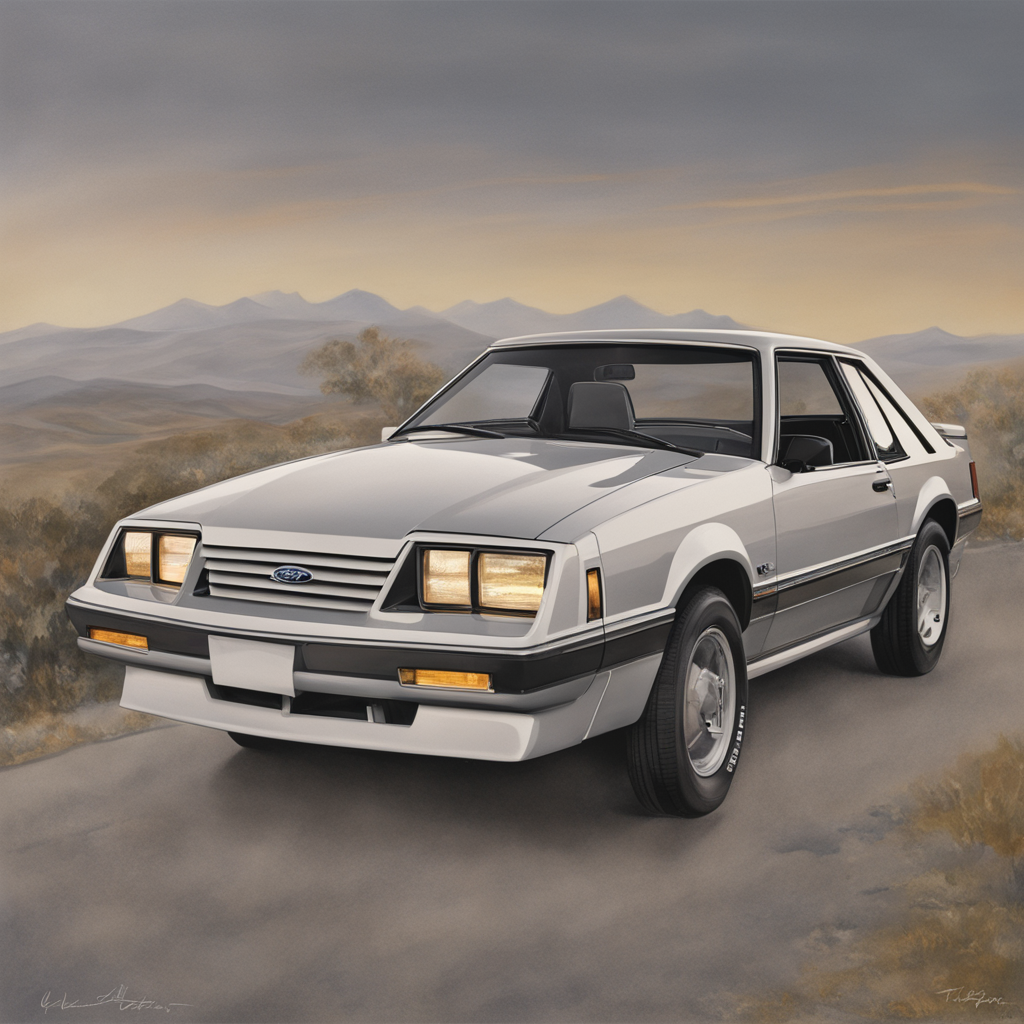Rebirth of a Legend: A Closer Look at the Iconic ‘86 Mustang
This article explores the significance, design, and performance aspects of the 1986 Ford Mustang, a pivotal year that marked a major turning point for the iconic muscle car.
Updated October 18, 2023
Brief History of the 1986 Ford Mustang
The 1986 Ford Mustang marks a significant milestone in its storied history. In the early 1980s, the Mustang had fallen out of favor with American car enthusiasts due to increased competition from foreign imports and domestic rivals like the Chevrolet Camaro and Pontiac Firebird. To revitalize interest, Ford redesigned the Mustang for 1986, introducing an all-new platform, updated styling, and improved performance capabilities.

Significance of the 1986 Ford Mustang Model Year
The ‘86 Mustang’s rebirth can be attributed to a combination of factors:
- A revised platform, dubbed the “Fox Body,” which provided better handling, more interior space, and improved safety features
- A bold new styling direction, characterized by rounded lines, pop-up headlights, and a prominent rear spoiler
- The introduction of fuel injection technology, which enhanced power and efficiency
These innovations helped reposition the Mustang as a credible competitor in the muscle car market.
Design and Styling of 1986 Ford Mustang
The ‘86 Mustang’s design was a departure from its more angular predecessors. The new look featured:
- A swooping front end with pop-up headlights, which improved aerodynamics
- A sloping hoodline that emphasized the car’s sporty stance
- Flared fenders and a prominent rear spoiler for added visual appeal
The styling refresh also introduced new colors, including “Tropic Orange” and “Frosty White.”
Color Options and Trim Levels
The 1986 Mustang was available in nine exterior colors:
- Tropic Orange
- Frosty White
- Black Clear Coat
- Bright Blue Metallic
- Garnet Red Metallic
- Silver Mink Metallic
- Medium Charcoal Gray
- Wimbledon White
- Forest Green Metallic
Trim levels included:
- LX: Base model with a focus on practicality and affordability
- GT: Performance-oriented trim with sport-tuned suspension, 17-inch aluminum wheels, and the GT Equipment Package (more on this below)
- Shelby GT-HO: A high-performance variant, limited to just 2,048 units
Performance and Specifications
The ‘86 Mustang’s performance capabilities were enhanced by:
- Engine options: 2.3L inline-four, 3.8L V6, and 5.0L V8 (Coyote engine)
- Horsepower ratings:
- 2.3L I4: 88 horsepower
- 3.8L V6: 140 horsepower
- 5.0L V8: 157 horsepower
- Torque ratings:
- 2.3L I4: 118 lb-ft
- 3.8L V6: 210 lb-ft
- 5.0L V8: 240 lb-ft
- Transmission options: 3-speed automatic, 4-speed manual, or 5-speed manual (for GT models)
Engine Options for the 1986 Ford Mustang
The ‘86 Mustang offered three engine options:
- 2.3L inline-four: A fuel-injected, 88-horsepower unit designed to improve efficiency and emissions
- 3.8L V6: A carbureted, 140-horsepower engine that provided a balance between power and economy
- 5.0L V8 (Coyote engine): A high-performance option with 157 horsepower, featuring fuel injection and a more aggressive camshaft profile

Horsepower and Torque Ratings for the 1986 Ford Mustang
- Engine: 2.3L inline-four
- Horsepower: 88 horsepower
- Torque: 118 lb-ft
- Engine: 3.8L V6
- Horsepower: 140 horsepower
- Torque: 210 lb-ft
- Engine: 5.0L V8 (Coyote engine)
- Horsepower: 157 horsepower
- Torque: 240 lb-ft
Transmission Options
The ‘86 Mustang offered three transmission options:
- 3-speed automatic: A smooth-shifting transmission suitable for daily driving and cruising
- 4-speed manual: A more engaging option for drivers who prefer hands-on control
- 5-speed manual (GT models): A high-performance transmission designed specifically for GT trim levels, providing a closer connection to the road
Variants and Special Editions
The ‘86 Mustang included several notable variants:
- Fastback: A sporty coupe with a sloping roofline and rear glass
- Convertible: A stylish drop-top model with a power-operated top
- Coupe: A classic two-door body style with a fixed roof
- GT Equipment Package (GTEP): An optional package for GT models, adding features like fog lamps, sport suspension, and 17-inch aluminum wheels
Impact on the Automotive Industry
The ‘86 Mustang’s rebirth had far-reaching implications:
- Competitor influence: The updated Mustang inspired its rivals to reinvigorate their own muscle car lines
- Market resurgence: The ‘86 Mustang helped revitalize interest in American muscle cars, paving the way for future classics
- Collectibility and value: As time passed, the ‘86 Mustang became a sought-after collector’s item, with certain models commanding higher prices
Sales Figures and Popularity
The 1986 Ford Mustang sold approximately 232,000 units worldwide, marking a significant increase from its predecessor.
Influence on Competitor Models
The ‘86 Mustang influenced:
- Chevrolet Camaro: General Motors responded by introducing the fourth-generation Camaro in 1982, featuring a more aggressive design and improved performance
- Pontiac Firebird: Pontiac followed suit with the Trans Am’s facelifted design for the 1986 model year
Collectibility and Value of 1986 Ford Mustang
The ‘86 Mustang has become increasingly valuable over the years:
- Base models: Worth around $5,000-$8,000 in good condition
- GT models: Commanding prices between $10,000-$15,000
- Shelby GT-HO models: Limited to just 2,048 units, these highly sought-after variants can sell for upwards of $50,000
Buying Guide When purchasing a ‘86 Mustang, consider the following:
- Condition: Inspect the car thoroughly for any signs of damage or wear
- Maintenance history: Review records to ensure regular servicing and any necessary repairs have been performed
- Engine performance: Test drive the vehicle to gauge its power and responsiveness
Conclusion
The 1986 Ford Mustang represents a pivotal moment in American muscle car history, marking a significant rebirth for the iconic brand. Its impact on the automotive industry is still felt today, as collectors and enthusiasts continue to seek out these sought-after vehicles. Whether you’re a seasoned collector or just starting your journey, the ‘86 Mustang remains an essential piece of Americana.

